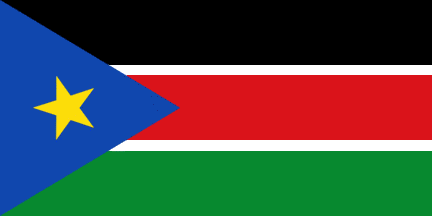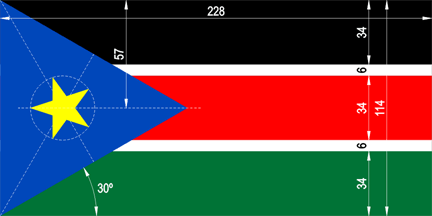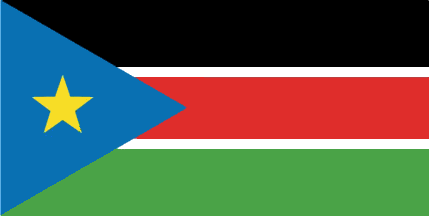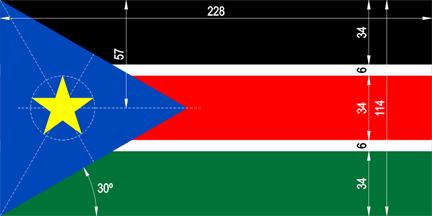 image
by Bruce Berry, 08 July 2011
image
by Bruce Berry, 08 July 2011
Last modified: 2015-05-24 by bruce berry
Keywords: sudan | south sudan | splm |
Links: FOTW homepage |
search |
disclaimer and copyright |
write us |
mirrors
 image
by Bruce Berry, 08 July 2011
image
by Bruce Berry, 08 July 2011
Following the signing of a peace accord between the government of Sudan and the rebel forces of the South in Nairobi 09 January 2005. There is a report from The Nation (Nairobi, Kenya) saying that under the accord, the South will not only enjoy political autonomy and the prospect of an independence referendum, but that the South is also entitled to fly a distinct flag. The flag is described as follows:
"The south will have a new flag that closely resembles
Kenya's in its
features and colours. A black stripe at the top represents the identity of
the eight million people. There is a star against a blue background
representing the River Nile. It signifies a future with optimism for the
people of southern Sudan.
Red stands for the blood shed by the southern Sudanese in the 21 years of
armed conflict while green stands for the region's agricultural potential."
Source: http://allafrica.com/stories/200501100007.html
It is not clear whether this describes the flag of the Sudan People's Liberation Movement
(SPLM), although this is the most straight forward interpretation, the description may stand for some other design as well.
Photographs forwarded by various news services showed the SPLM flag being flown in the celebrations following the peace treaty.
The status of the Southern Sudan region is not yet clear not it is guaranteed that the agreement shall be implemented.
Jan Oskar Engene, 10 January 2005
Africa's newest
state comes into being today with the independence of South Sudan. South Sudan
voted for secession and independence from Sudan in a referendum on 09 January
2011. The referendum was a condition of a peace agreement between the Sudan
People’s Liberation Army/Movement (SPLA/M) and the Government of
Sudan which was
represented by the National Congress Party. The agreement ended Africa’s longest
running civil war. The Machakos Protocol, signed between the Government and SPLA
in 2002, provided for the south to seek self-determination after six years. This
was followed by the Comprehensive Peace Agreement (CPA) signed on 09 January
2005. The CPA is a set of protocols which includes a permanent ceasefire,
developing democratic governance and accords on wealth and power sharing. In
terms of the CPA, and based on the outcome of the referendum, independence was
proclaimed on 09 July 2011.
The accord also allowed the Government of
South Sudan to fly a distinctive flag which is now flown as the national flag of
Africa's newest state - the Republic of South Sudan. The flag comprises three
horizontal stripes of black, red and green, separated by white fimbriations. At
the hoist is a blue triangle in the centre of which is a yellow five-pointed
star pointing to the upper hoist The black stripe symbolises the 8 million
people in South Sudan and while the yellow star symbolises a future with
optimism for the people of South Sudan and the blue background represents the
Nile River. Red stands for the blood shed during the 21 years of armed conflict
while green stands for the region's agricultural potential.
Bruce Berry, 08 July 2011
According to
CIA-The World Fact Book, the flag of South Sudan is described as follows:
"Three equal horizontal bands of black (top), red, and green; the red band is
edged in white; a blue isosceles triangle based on the hoist side contains a
gold, five-pointed star; black represents the people of South Sudan, red the
blood shed in the struggle for freedom, green the verdant land, and blue the
waters of the Nile; the gold star represents the unity of the states making up
South Sudan".
The design resembles the flag of Kenya and it is one of
only two national flags to display six colours as part of its primary design -
the other being the flag of South Africa.
Cai Zhenyuan, 12 Aug 2011
There is a description of symbolism of South Sudanese flag on the official
website of the
Government of South Sudan (GOSS):
"Black represents the black African people of Southern Sudan. White
represents Sudan peace for which many lives have been lost. Red represents the
blood of the gallant freedom and justice fighters who have been lost in the many
years of conflict. Green represents agricultural potential exemplified by the
fertile soil and rich equatorial vegetation adorning the Southern Sudan
countryside. Blue represents the River Nile, which is the main source of life
not only in the Southern Sudan but also in the North and all the way to
Egypt.
The Star - represents unity of the states of Southern Sudan. The flag,
therefore, signifies one nation of black Africans united in the struggle to
perpetuate peace and prosperity for all the people of Southern Sudan."
Zoltan Horvath, 11 Jan 2011
 image
by Martin Grieve, 01 Sept 2011
image
by Martin Grieve, 01 Sept 2011
The Chief of State Protocol at the Office of the President of the Republic of
South Sudan issued on 22 October 2012 a document called "Restrictions on the use
of the Seal of the Republic, the National Coat of Arms, the Presidential Flag &
the National Flag" which is available
here.
We learn from this document that there are a National Flag Act (2011) and a
National Coat of Arms Act (2012) but no text is provided.
Jos Poels, 31 Oct 2012
.gif) image located by Zoltán Horváth, 06 Jan 2011
image located by Zoltán Horváth, 06 Jan 2011
Source:
http://img541.imageshack.us/img541/7863/66057685.jpg
According to the Government of South Sudan website,
the prominent feature of the coat of arms is the African fish eagle (Haliaeetus
vocifer), which is common in most areas of South Sudan. It symbolizes
vision, strength, resilience and majesty. The eagle is leaning against a
traditional shield and crossed spear and spade which symbolize the people’s
resolve to protect the sovereignty of their republic and work hard to feed it.
Bruce Berry, 16 Aug 2011
.gif) image
sent by Erwin Hoheisel, 26 July 2011
image
sent by Erwin Hoheisel, 26 July 2011
The African fish eagle also features prominently in the State Seal as shown
above.
Erwin Hoheisel, 26 July 2011
The "Sudan Tribune" (16 February 2011) reports that:
"Leaders of political
parties at a meeting in Juba have unanimously agreed that the new state to be
created in the region will be be called the Republic of South Sudan (RoSS).
[...]
In a separate press conference on Wednesday, the minister of Peace and
CPA Implementation, Pagan Amum, who also serves as the SPLM’s secretary
general, said that the emerging independent state will be formed on
inclusivity of all the political parties in order to achieve a smooth
transition. He said the SPLM’s political bureau, the highest political body
of the party, also approved the name of the Republic of South Sudan for the
new state on Monday. Amum also added that the party preferred the SPLM flag,
which has already been serving as an interim flag for the Government of
Southern Sudan, to remain as the national flag of the new independent state.
It will however be subjected to endorsement by all the political parties
and after which the political decision will be presented to the parliament
for further deliberations and final endorsement."
http://www.sudantribune.com/South-Sudan-political-parties-to,38012
Ivan Sache,
17 February 2011
On 22 March 2011, the cabinet of South Sudan "approved some of the
proposed sovereignty symbols for the region, including the name of the new
independent state, its flag, national anthem and its new currency, after long
deliberations."
The flag is that of the SPLM of 2005 which has been used an interim flag by
GOSS. No
word about the coat of arms.
http://www.sudantribune.com/South-Sudan-cabinet-approves,38367
Chrystian Kretowicz, 24 March 2011
There was a call for proposals for a new coat of arms for the Republic of South
Sudan, as can been found on the website of the Government of Southern Sudan:
Design for Coat of Arms advert
JUBA, 17 March 2011 - The
Ministry of Culture and Heritage, Government of Southern Sudan (GOSS), wishes to
invite artists and thinkers to design various symbols of authority, including
the Coat of Arms, of the new Republic of South Sudan. Please, click
http://www.goss-online.org/magnoliaPublic/en/news/mainColumnParagraphs/08/content_files/file/Culture%20Ads.pdf
here for the details.
Jos Poels, 24 March 2011
 image
by Martin Grieve, 01 Sept 2011
image
by Martin Grieve, 01 Sept 2011
The flag hoisted outside the United Nations headquarters has an upright star as
seen in this photo.
It seems to have a lighter blue triangle than shown in other photos.
Helge Jacobsen, 13 Aug 2011
There seem to be several different variants of the national of South Sudan flag.
While most flags at the independence party showed a dark blue triangle with a
star, pointing to the corner, some had a star which points straight up.
J. Patrick Fischer, 30 Aug 2011
I have mentioned this before, but we might as well plan on South Sudan variants
to be the norm both in color, proportions and particulars when it comes to the
star.
Relative to South Sudan's flag, the collective is not going to worry much about
which shade of blue, green, red, or yellow is used in the flag. Which way the
star faces will not matter. The exact proportions of the hoist triangle will be
of no consequence. Will the flag be proportioned 2:3?, 3:5?, 1:2?, or something
else all together? The answer is all of the above.
At the end of the day, there may be a set of exact specifications, but the
average citizen won't pay much attention and a variety of flags are likely to be
displayed.
Clay Moss, 31 Aug 2011
 image
by Martin Grieve, 01 Sept 2011
image
by Martin Grieve, 01 Sept 2011
The official website of Government of the Republic of South Sudan shows the
national flag and coat of arm images as its State Symbols.
The flag has light blue triangle and straight yellow star just like flag hoisted
at UN.
Nozomi Kariyasu, 01 Sept 2011
On 09 July 2005 John Garang took the oath in Khartoum as the Vice-President of
Sudan. It had not been done in Khartoum for the last 22 years. Until recently,
Colonel John Garang was the leader of the rebellion of
the Animists and Christians of the south of the country against the
Islamic regime of General Omar Al-Bashir. According to the peace treaty
signed in January 2005, Garang left his title of Colonel and will go
back to Juba, his capital city. A transition Constitution was adopted
on 06 July 2005; accordingly, Garang's movement (the Sudanese People's
Liberation Movement) is now a political party with 28% of the seats in
the Parliament. Al-Bashir's National Congress holds 52% of the seats,
the northern opposition 14% and the southern opposition 6%. General
elections shall take place in four years. In six years, the people
from the south shall decide to stay in the Sudanese Confederation or to
leave.
According to the transition Constitution, the south will have its
semi-autonomous Parliament and government, its Constitution, army,
banks, courts and "national" anthem and flag.
John Garang was born in 1945 in the southern city of Bor, in the Dinka
country. He studied economy in Iowa (USA) and joined the Anya-Nya
insurrection in 1970. Peace was signed two years later and Garang was
appointed Colonel in the Sudanese Army, after an infantry training in
Fort Benning, Georgia (USA). In September 1983, General Jaafar Nimeyri,
then ruler of the country, sent the army to repress an insurrection
against the Islamic law in the city of Bor. The 105th Battalion and his
commander, John Garang, deserted, and formed the core group of the
Sudan People's Liberation Army. In 1991, the rebels were repelled
southwards by Al-Bashir's militia and the movement split between the
Dinkas and the Nouers.
After Monique Mas, Radio France International, 08 July 2005, Ivan Sache, 12 July 2005
The parts relative to flags (courtesy of Jos Poels) read as follows:
2005, July 9Christopher Southworth, 12 July 2005
Interim National Constitution of the Republic of the Sudan
Part One - The State, Constitution and Guiding Principles
Chapter I - The State and the constitution
Article 9 - National Symbols
The law shall specify the national flag, national emblem, national anthem, public seal, medals, national festivals and commemorations of the State;
Article 5
Schedule A: National Powers
Exclusive competencies (Legislative and Executive Powers) of the National Government.
(.)
24. National Flag, National Emblem and National Anthem;
Schedule C: Powers of States
Exclusive executive and legislative competencies of the individual States of Sudan shall be as set out hereunder:-
(.)
45. Flag and emblem.
The New York Times (02 Aug 2005) shows the coffin of the South Sudanese leader
(and overall Sudanese Vice President) covered with the "New Sudan Flag" (yellow star version).
The online
version
interestingly shows the coffin covered with two overlapping flags, the hoists
at opposite ends and the top stripe on both sides.
Nathan Lamm, 02 Aug 2005
South Sudan became independent two
years ago after 44 years of armed struggle. An overview of the flags which
played a role in the war of independence can be found on this
website.
Jos Poels, 16 Mar 2013